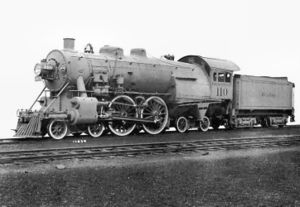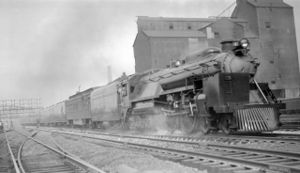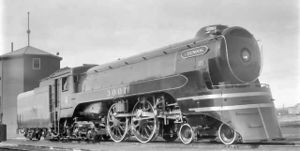4-4-4
A 4-4-4, in the Whyte notation for the classification of steam locomotives by wheel arrangement, is one with four leading wheels arranged in a leading truck, four coupled driving wheels (two driving axles), and four trailing wheels in a trailing truck. In the United States, this arrangement was named the Reading type, since the Philadelphia and Reading Railroad was the first to use it. In Canada, this type was known as the Jubilee.
The equivalent UIC classification is 2'B2'.
Contents
Bavarian S 2/6
A single, experimental 4-4-4, classified as S 2/6, was built for the Royal Bavarian State Railway Company in 1906 by the firm of J.A. Maffei. It was successful in an experimental sense but was too light to haul passenger trains of useful capacity. It was fast, attaining 154 km/h on test, and was semi-streamlined with a pointed nosecone and fairings around the cylinders, stack and dome, and slanted-back cab windows. It inspired the later Bavarian S 3/6 4-6-2 "Pacifics". It passed to the Deutsche Reichsbahn Gesellschaft when the German railways were centralised, and was classified as BR 15, number 15 001. It was taken out of service in 1925, and was restored by Maffei to be exhibited at the Munich Transport Exhibition of that year. After the exhibition ended, it was placed in the Nuremberg Transport Museum, where it remains.
Reading C1a
The Reading Railroad built four locomotives of the 4-4-4 type in 1915, class C1a, road numbers #110-113. They used front and rear trucks that were effectively identical. During a year of operation, they proved to be quite unstable; after that year, they were rebuilt to 4-4-2 "Atlantic" locomotives, reclassified as P7sa, and renumbered #350-353.
| Builder | Reading Company |
|---|---|
| Cylinders | 23.5 × 26 in (597 × 660 mm) |
| Weight (engine) | 230,800 lb (104,700 kg) |
| Steam pressure | 240 lbf/in³ (1.65 MPa) |
| Driver diameter | 80 in (2.03 m) |
| Tractive Effort | 36,604 lbf (162.82 kN) |
Baltimore & Ohio No. 1 Lady Baltimore
The Baltimore and Ohio Railroad created a single 4-4-4 in 1934, rebuilding a 4-4-2 "Atlantic" into a solitary class J-1, named Lady Baltimore. Along with the single class V-2 4-6-4 Lord Baltimore, it was built for new lightweight passenger trains, in the Lady Baltimore's case the Abraham Lincoln on the Chicago and Alton Railroad, a wholly owned subsidiary of the B&O.
Despite the Alton's flat territory and straight track, the locomotive did not do well. It was returned to the B&O and was again modified at the railroad's Mont Clare shops, a less streamlined cab and front end being fitted. Subsequently, it was placed into local service on the railroad's Wheeling Division, mostly operating between Holloway and Cleveland, Ohio.
It proved no more successful in that service, and was sent to the B&O's Riverside Shop for storage; it was scrapped in 1949.
Canadian Pacific "Jubilee"
The Canadian Pacific Railway built two classes of 4-4-4 "Jubilee" locomotives. Both were semi-streamlined, in a similar fashion to the 4-6-4 "Royal Hudson" and 2-10-4 "Selkirk" locomotives.
Class F2a consisted of five locomotives, #3000-3004. They can be easiest distinguished from the other type through the main rods being connected to the leading pair of drivers. The pilot was smoothly rounded and streamlined, with two stainless-steel bands. None of this group survive.
Class F1a consisted of twenty locomotives, #2910-2929. These had the main rods connected to the trailing set of drivers, and a more regular pilot, with a straight pilot beam, a drop-coupler sheet steel pilot below that, and a more regular front deck. Two of this class of locomotive, #2928 and #2929, have survived. #2928 is at the Canadian Railway Museum in Delson, Quebec, while #2929 is at Steamtown National Historic Site in Scranton, Pennsylvania.
References
- Ehrenreich, Thomas. 1915 Reading Company Locomotive 110. Retrieved on May 18, 2005.
- Barris, Wes. SteamLocomotive.com: Surviving Streamlined Steam. Retrieved on May 18, 2005.
- Canadian Pacific Railway No. 2929. Steamtown NHS Special History Study. Retrieved on 2006-01-25.
- Wilbrink, Joost. BR 15. dbtrains.com. Retrieved on 2006-01-25.
Steam locomotive types | |
|---|---|
| Single engine types | 0-2-2 • 2-2-0 • 2-2-2 • 2-2-4 • 4-2-0 • 4-2-2 • 4-2-4 • 6-2-0 0-4-0 • 0-4-2 • 0-4-4 • 2-4-0 • 2-4-2 • 2-4-4 • 4-4-0 • 4-4-2 • 4-4-4 0-6-0 • 0-6-2 • 0-6-4 • 2-6-0 • 2-6-2 • 2-6-4 • 2-6-6 • 4-6-0 • 4-6-2 • 4-6-4 0-8-0 • 0-8-2 • 0-8-4 • 2-8-0 • 2-8-2 • 2-8-4 • 2-8-6 • 4-8-0 • 4-8-2 • 4-8-4 • 4-8-6 • 6-8-6 0-10-0 • 0-10-2 • 2-10-0 • 2-10-2 • 2-10-4 • 4-10-0 • 4-10-2 0-12-0 • 2-12-0 • 2-12-2 • 2-12-4 • 4-12-2 • 4-14-4 |
| Duplex engine types | 4-4-4-4 • 6-4-4-6 • 4-4-6-4 • 4-6-4-4 |
| Garratt (articulated) types | 0-4-0+0-4-0 • 2-6-0+0-6-2 • 4-6-2+2-6-4 • 2-8-0+0-8-2 • 4-8-2+2-8-4 • 4-8-4+4-8-4 |
| Mallet (articulated) types | 0-4-4-0 • 0-4-4-2 • 2-4-4-2 0-6-6-0 • 2-6-6-0 • 2-6-6-2 • 2-6-6-4 • 2-6-6-6 • 2-6-8-0 • 4-6-6-2 • 4-6-6-4 0-8-8-0 • 2-8-8-0 • 2-8-8-2 • 2-8-8-4 • 4-8-8-2 • 4-8-8-4 2-10-10-2 • 2-8-8-8-2 • 2-8-8-8-4 |



